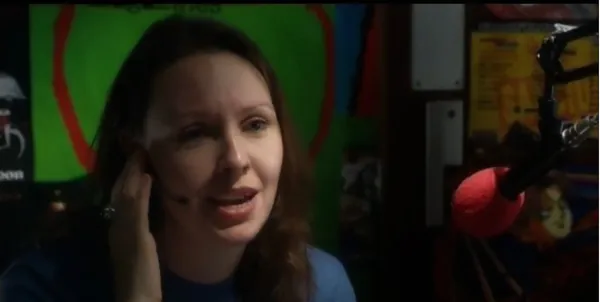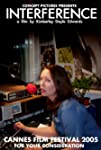Eye For Film >> Movies >> Interference (2005) Film Review
Interference
Reviewed by: Andrew Robertson

With a small cast, a small location, and lofty ambitions, Interference manages to tell a tale of planetary significance without leaving the room. A staple of small budget play and film, the single chamber apocalypse can still be revelatory.
Here the one room is a radio broadcast booth, well dressed for the film's purposes from Cheltenham Cotswold Hospital Radio's facilities. Dressed with posters and printing that all point to conspiracy, from The Third Man to the pages of the fictitious Daily New Yorker it feels the part.
Helped by lighting and language, we are firmly into the graveyard. Figures of some authority might be listening in, but not enough to worry about FCC violations. Them and not OFCOM, as we are in the city that never sleeps, the metropolis they named twice.
That factors into the paranoia. Amidst homage to 2001 there's a fair bit of leftover Cold War angst. No cuckoo clock here, instead terraforming Mars, driven by consideration of climate change. The T-shirt on our disc jockey has text from the Brandenberg Gate, but the death's head American flag speaks to another date.
That DJ is Jennifer Belander, dealing with static, operating from a near fixed position, Sam the weary slave of the graveyard. She's got regular callers, an engineer, a supervisor, but this is a one-and-a-half hander in truth. The other voice, the interlocutory antagonist, the mysterious Eagle 06400.
This was shot in 2005 or so. Pre-smartphone or near enough, not quite at internet ubiquity. There is a URL on a masthead but no computers in the studio. The telephones are lighting up and the station has gone dark. The film opens with a black screen, shuffling across the dial in FM fashion. Though we're in uncharted territory, 203.9 FM is outwith the range afforded to radio. It actually (fact fans) reaches into Band III, in North America subdivided for television broadcasting. That frequency is just on the edge of 11, on the periphery of the interzone with 12. That's a fair few shy of 83, CIVIC-TV, but we are at the foothills of Videodrome.
I mention as many other science-fictionals because this is rooted in that territory, though perhaps weakly. Not for lack of effort, nothing distorts with time like visions of the future. Here the future has already intruded, there's mention of terrorism but no amount of War Games, however randomly dialled, are likely to hit upon this situation.
The future too matters. Writer/director Kimberley Dayle Edwards would go on to have one, albeit under a different name. As Kitty Brucknell she'll be known to fans of X-Factor. I can tell you that Koensayr built the Y-Wing but I couldn't tell you which series or stage she reached, but that's fandom.
As a historic artefact of past creativity it stands up well. The nature of its cinematography, old digital, dates it in a way that film grain wouldn't. The nature of its setting with manned overnight FM radio now often replaced with automatic DAB speaks to its transitional era. Indeed, the replacement of humans with machines becomes a factor in its plot.
Co-written with Phil Clarke, his only credited work as writer, it's a taut little piece. Where it fades out one finds oneself wiggling the metaphorical aerial, trying to tune it back in. Clarke's production chops and script doctoring and writing presumably all helped, but as with any co-writing it's hard to determine which half did which 80% of the work. It doesn't matter because the work succeeds.
Though she would be later more famous for her own voice, Kimberly/Kitty uses them well. The reaction of the listeners to what they assume is a piece like War Of The Worlds is well handled, more so the horror in the booth because they're not sure it was. There's a genuine glimpse of workplace tedium, anyone who has done shifts that start and finish in the dark will be able to relate.
The version on YouTube opens with an autobiographical note. The film was written by Kimberley/Kitty as a teenager, shown at Cannes in 2005, and then fate had something different in mind. Apt, admittedly, given the nature of the film. The suspicion, however, is that this will be her only directorial work, which on this showing would be a shame. Interference has a way of getting through, and constructively. There's meaning amongst its noise, it is worth tuning in.
Reviewed on: 07 May 2021

















